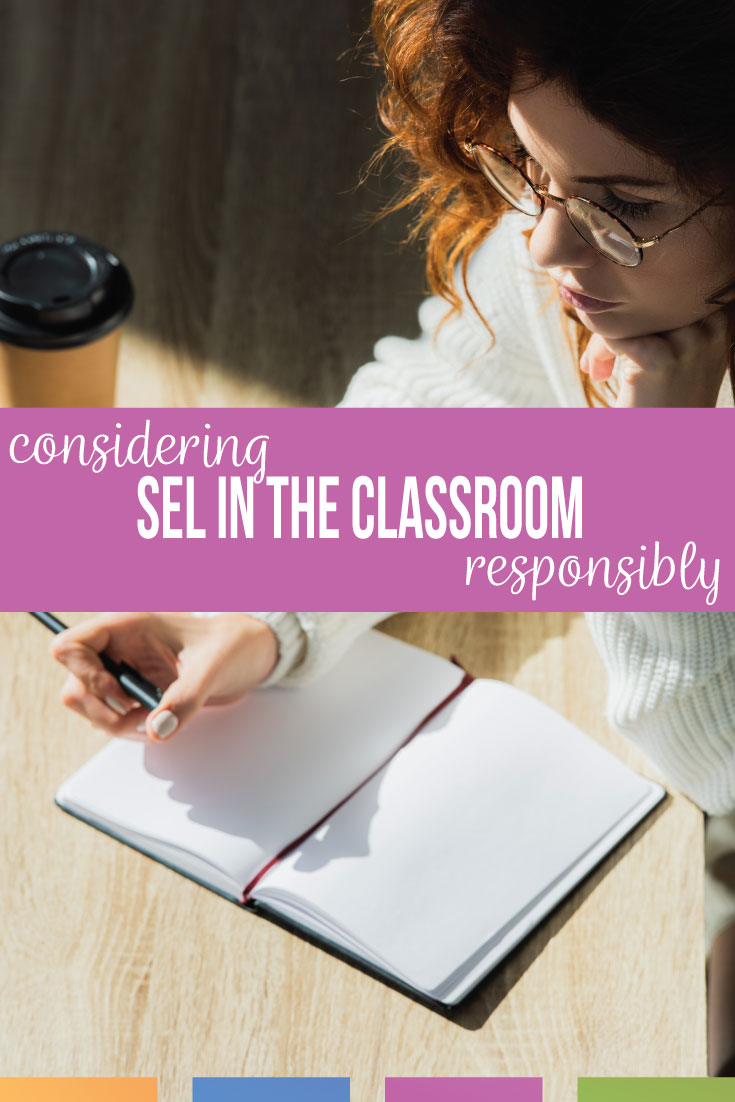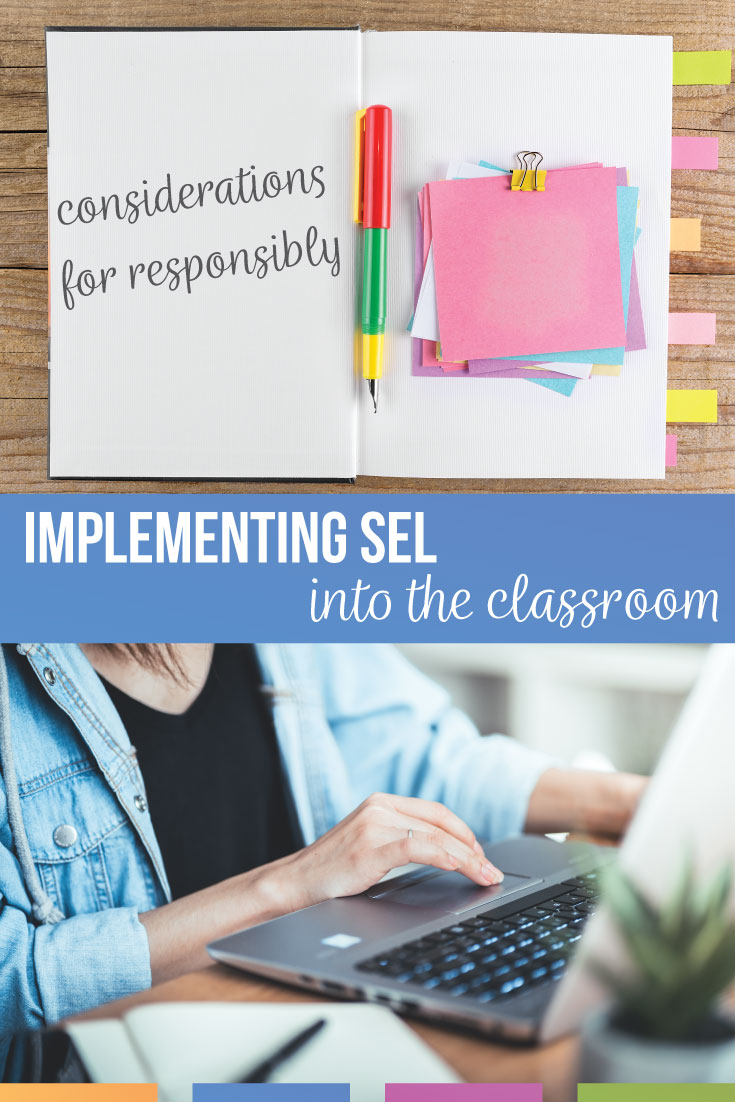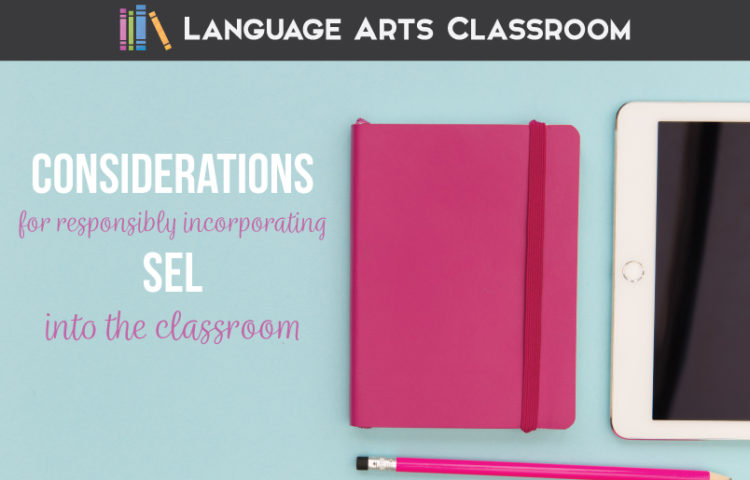Considerations for SEL in the classroom: social and emotional learning.
This previous year, teachers and students experienced a mass upheaval. As a teacher on social media, I saw an uptick in SEL activities. Overall, teachers were concerned with SEL for their students.
I was concerned too! My relationships with students changed, and I missed my classes. As the school year approaches for the 2020-2021 school year, I’ve been reading, researching, and thinking about relationships with students. SEL is part of relationships, and relationships lead into classroom management, which then circles around to trauma-informed teaching and an equitable classroom. SEL and trauma along with our current society and specific school communities create a complex veil that covers our teaching.
In short, all of these components fit together, especially when you combine the fact that we’re in the middle of a pandemic. If we teachers consider those concepts (social emotional learning or SEL; relationships; classroom management; and trauma-informed teaching) AND then throw in our content? I’m overwhelmed. I want to do it all well; I want to make my classroom safe.
SEL classroom activities can be helpful. They can also be hurtful.
In this post, I’m writing about considerations for SEL in the classroom with the caveat that SEL is part of a much bigger picture. Many pieces interact and overlay.
Background
First, I’m a teacher who had a traumatic childhood. Those two facts are intertwined. I normally don’t write about the second fact, but when I do, teachers message me and ask for more ideas. That’s fair, and I am happy to provide a perspective that others might not have. Plus, I’ve received professional development as a teacher to implement trauma-informed teaching practices. In this blog post, those experiences (as a student and a teacher) shape my ideas.
Second, SEL seems promising. Because I’m concerned about what this school year would like like concerning relationships with students, SEL, equitable classrooms, and trauma-informed teaching, I went searching for best teaching practices. I came across this SEL kit, and although it looks deep, it looks worthwhile. These ideas seem helpful as well. If SEL in the classroom will help my students, I want to implement those ideas.
Third, I’m writing this blog post with an assumption: All teachers want what is best for their students. It might be a big assumption, but I believe it is true, especially if you are searching for safe SEL in the classroom.
Finally, if you are looking for more ideas that I present in this post, I suggest several books that have helped me understand trauma and students: The Body Keeps the Score; The Boy Who Was Raised as a Dog; and Reviving Ophelia. Like so much in life, my to-read list is long, and I’m sure more books about SEL and trauma exist. But, those three books are easy to understand, and educators will find the information applicable to the classroom.
The classroom
When I think of considerations for SEL in the classroom, I ask myself several questions. As I reflect and grow as an educator, I’m sure these questions will change. I consider:
- What will help students, and what will NOT hurt students? Concerning SEL activities, am I hurting students?
- What do doctors say? What does the research say? What professionals have guidance for how to implement SEL in the classroom?
- How can I best set up my students for success in my classroom and in life?
- How can I protect our students who need help the most?
Those questions and reflections shape my activities and discussions with students.
I mentioned earlier that I researched activities and ideas; many were specific to SEL and trauma. Since this school year might be done piecemeal, I want to engage my students when we meet in person and continue those relationships if we return to distance learning.
I came across a few SEL activities that bothered me, and I want to present my perspective to you. I don’t have specific ways for how to implement SEL in the classroom, but as a teacher and a survivor, I want to share my perspective with you.

Failed SEL activities
My fear for students is that teachers who believe they are doing right will unintentionally hurt students, the exact opposite of what we should do, especially concerning SEL classroom activities. Specifically, I’ve seen two activities on social media that attempt to foster student relationships and build SEL in the classroom, but they both fail miserably. I’m summarizing them below and explaining why they are not constructive activities for the classroom.
The trash bag or note card examination
What it is:
The teacher asks students to write down their problems or obstacles in life. The student then “throws away” the problems in the trash bag or hands the teacher the problem.
With the trash bag, the student is getting rid of their problems. With the note cards, the students are trusting the teacher with their problems. A worse version includes reading the problems aloud.
The problems:
First, teachers just asked students (maybe on the first day of school when nerves are high) to write down traumatic experiences, often ones that they have no control over. Now, students are focused on their trauma.
Second, relationships don’t form like that. Students (especially ones with traumatic histories) won’t trust you because you encouraged them to share their trauma with you. Authentic relationships take time to create.
Third, students are not focused on education. They are not focused on being safe, on studying, on getting acclimated. They are focused on hiding or sharing a traumatic experience.
Fourth, are you going to read through those problems? Many of them probably warrant a call to family services.
Fifth, trauma does not have a Hollywoodesque, golden ending. Writing down a problem in your life and throwing it away or giving it to a complete stranger does not solve that problem, does not ease the trauma. The entire activity doesn’t even accomplish the goal.
Those are five problems, and I could probably think of more. It’s a dangerous SEL activity. When looking at the classroom strategies to promote SEL, it does not align with those strategies.
The other premise is less of an activity and more of a stationed reminder for students.
The mirror
What it is:
A teacher or counselor hangs a mirror and and labels it in several ways. A sign above it might read, “Meet the person responsible for your happiness, your grades, success, choices, motivation, future. . . ” Another one might read, “You control your clothes, attitude, work, and friends.”
The problems:
First, those signs are inaccurate. Outside forces often dictate student success. Students are minors, and they don’t control their lives.
The inaccuracies abound. For example, “Having a parent in prison can have an impact on a child’s mental health, social behavior, and educational prospects.” Some students are hungry. Other students live in poverty. Racial disparities hurt students.
When you tell students that they are responsible for parts of their lives that they in no way can control, you are not building social and emotional learning. Imagine a child who:
- Dealt with sexual abuse less than twelve hours ago standing in front of a mirror that tells them that they are responsible for their attitude and clothes.
- Rearranged their hair to cover a bruised neck reading they are responsible for their happiness.
- Closed a restaurant six hours ago, handed money over to their parents, and barely slept reading they are responsible for their success. (They probably can’t stay awake.)
- Is called racial or homophobic slurs in the hallways or at home looking into a mirror and reflecting that their teacher thinks they are responsible for. . .
None of these are fun thoughts, and we teachers are incredibly aware that we don’t catch every instance of abuse or neglect. These hypothetical instances, however, accurately reflect some of our students’ lives.
Finally, I’m not saying we shouldn’t encourage or challenge students. The brain processes information based partially on experiences:
It is especially important to teach students to question their assumptions and the possible influences of past experiences and unconscious biases on their feelings and beliefs.
I think the mirror is an attempt at teaching students about their assumptions in life, but the overall “in your face” messaging is harmful. Could we work with students and incorporate SEL without the mirror? Could we make SEL classroom activities simple, perhaps with check-ins?

Overall educator attitudes
I’ve mentioned before that my childhood was traumatic. When I look at my students, I worry about the trauma in their lives even though statistically, not all of them face trauma. I also know that statistically, not all teachers have experienced trauma and therefore, their experience provides a different lens for looking at students. I wrote out those above questions to help shape SEL activities.
One overall concept with student relationships is our preconceived ideas as educators.
Years ago, I was in a teacher’s high school classroom, and a student walked in. The student had on a short shirt, an incredibly short shirt. The shirt clearly broke the school’s dress code; the teacher asked the student to get a jacket, and the student went to get it.
After the student left, the teacher turned to me and said, “Where is that girl’s mother?”
Well, I don’t know. I don’t know where that girl’s mother is.
I will tell you that when I was in high school, I didn’t see my mother before I went to school. She was in bed. Sometimes when I got home from school at 3:30, she was still in bed.
Whatever preconceived notions you have about children coming to school, please check them. Students don’t control their home lives. Their home lives affect their lives at school. Physical health affects the brain and brain development. As much as we want to encourage students, they simply cannot control every aspect of their lives, their brains might be compromised from trauma, and their brains are not fully developed.
And please, if you are thinking of implementing SEL in the classroom, consider vulnerable students. Consider SEL and trauma.
In closing
We have all made mistakes. I have made mistakes. I cringe when I think of students I perhaps hurt by trying to do the right thing but actually doing the wrong thing. Professionals (no matter the field) make mistakes. We have to admit them and do better.
As teachers learn more and see more research, our considerations for SEL in the secondary classroom will evolve. In writing this post, I don’t mean to condemn anyone or ask for sympathy. Recently with discussions of SEL, trauma-informed teaching practices, equitable teaching practices, and relationship building, I began thinking. Whenever I share my experiences, teachers privately message me and thank me for giving them a new lens for looking at their students. My hope is that I did that in this post. (If you’d like to chat more, you may leave a comment or email me.)
What considerations for SEL will you implement in your classroom? What are your overall thoughts on safe SEL activities?
EDIT:
Thanks for all of the positive reception to this post.
A common question from teachers on Instagram revolves around prefacing activities with, “You don’t have to do this if you don’t want. . .”
Explaining that students don’t have to complete an activity won’t work with traumatized students. In fact:
A child who feels powerless or who grew up fearing an abusive authority figure may react defensively and aggressively in response to perceived blame or attack, or alternately, may at times be overcontrolled, rigid, and unusually compliant with adults.
And:
They may struggle with sustaining attention or curiosity or be distracted by reactions to trauma reminders.
Asking students to share trauma under the guise of a class activity is poor practice. Specifically, those students might simply comply or be distracted because of their trauma.

